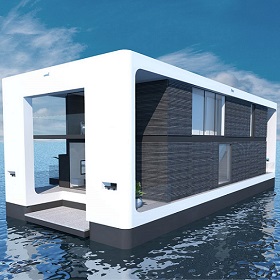If economic history has taught us anything, it’s that innovation always fills an economic void. Today, a housing startup called Arkup is marketing a novel form of living to a populace increasingly mindful of climate change.
To create what it calls “livable yachts” meant to withstand category 4 hurricanes, Arkup has taken the concept of the houseboat and added luxury and resilience. Its self-propelled, waterborne homes offer more than 4,000 square feet of living space, run on solar power, and feature extendible stilts that can protect the home from turbulent seas, according to a recent Business Insider article.
Timing may work to the new company’s advantage. Some real estate and insurance experts believe the value of waterfront property could decline in the years ahead. In the past decade alone, the average premium that homebuyers are willing to pay for waterfront real estate has dropped from more than 50 percent to 36 percent, according to research by Zillow.
To answer the call of residents who value waterfront living but fear the consequences of a volatile climate, Arkup has partnered with a Miami yacht company to charter and sell its new floating homes.
Matching an Economic Need
A 2017 Yale survey found that 71 percent of Americans believe global warming is happening, and 22 percent say they’re “very worried” about it—more than twice the number who said so two years earlier.
That sounds like a sizable market for Arkup to address, but the company’s pool of prospective buyers is actually much more select, not least because its waterborne yacht costs $5 million. To market to those well-heeled buyers, Arkup and other companies marketing luxury sustainable goods need deep insight on where they live, work, and play.
Retailers, banks, prominent consumer brands, and other businesses have performed this kind of analysis for decades, often with the help of geographic information systems (GIS) technology. A GIS ties information to location, creating what’s known as location intelligence.
Location intelligence can be a valuable marketing tool for startups and established companies. Take Wayne Johansen, founder of HOM Furniture, who credits location intelligence with helping his company grow from a startup to the eighth largest regional furniture chain in the country.
Johansen discovered location intelligence with help from the marketing department at the Star Tribune, where HOM advertised. HOM was looking for particular types of buyers, and the newspaper’s GIS analysts found them by plotting demographic data on a map, revealing in startling detail traits such as income, age, family size, and lifestyle interests.
“We were in a fast-growth stage and we felt that we had a winning game plan,” Johansen told WhereNext. “But the execution became much more scientific and precise with [those] tools and analysis.”

To market to prospective customers ahead of the competition, companies will need more than ingenuity and disruption. They’ll need effective data and actionable location intelligence.
Finding Customers to Boost Growth
A recent survey by the University of Redlands found that 83 percent of industry-leading, location-savvy companies consider location intelligence a valuable tool for discovering customer insight. By comparison, only 26 percent of spatially immature companies share that view.
For companies with sustainability-focused products and services to sell—including floating homes built for wealthy buyers concerned about the effects of climate change—location intelligence can deliver valuable insight on the customers who will help their business grow.